This study explores the landscape of news on YouTube through a survey of YouTube news consumers alongside an analysis of the most popular YouTube channels that produce news and the videos published by a subset of these channels. Here are some definitions of key terms used throughout this report:
- YouTube news consumers: Those who said they get news from YouTube in a Pew Research Center survey of U.S. adults conducted Jan. 6-20, 2020.
- YouTube channel: A webpage on youtube.com where a specific video creator’s videos are organized. For example, Pew Research Center’s YouTube videos are all found on this page. The channel owner can control what information is on the page, including the description of the channel and which videos are featured.
- Popular YouTube news channels: These are the 377 YouTube channels with at least 100,000 subscribers which dedicated a majority of their 15 most recent videos in November 2019 to news or current affairs as determined by a set of trained human coders. These channels were selected after examining over 17,000 channels that were recommended by YouTube’s algorithm after viewing a video from a shorter list of known news channels.
- Most viewed YouTube news channels: These are the 100 popular YouTube news channels with the highest number of views on their median video from December 2019 (while news channels were initially selected based on November data, they were included in the “most viewed” sample based on December data, and only videos from December were analyzed in Chapter 2). A representative sample of 2,967 videos from these channels was analyzed.
- Channel affiliation: This is the external organization, agency or group that a news channel is connected with. Many channels are the YouTube home for an entity that has a significant presence outside the platform. For instance, Pew Research Center’s YouTube page is the Center’s home on YouTube. Each popular YouTube news channel was examined for affiliation.
- News organization channels: These are news channels that are affiliated with an external news organization, such as the YouTube page for CNN or Fox News.
- Other organization channels: These are news channels with an external affiliation that is not a news organization. Examples of other organizations include research organizations, advocacy groups and government agencies.
- Independent channels: These are news channels that do not have a clear external affiliation.
- Personality-driven channels: These are news channels that feature a recurring host and orient their channel’s content around the host’s personality, such as the channel for The Daily Show with Trevor Noah. These channels can be associated with a news organization, another organization or be independent.
- Public figure channels: These are personality-driven channels hosted by individuals who had a public profile before they created a YouTube channel. Public figure channels may be affiliated with an external organization. Examples include Bill O’Reilly and Last Week Tonight with John Oliver.
- YouTuber channel: These are personality-driven channels hosted by individuals who did not have a public profile before they created a YouTube channel (although many are in the public eye now). YouTuber channels generally are not affiliated with an external organization. Examples include Philip DeFranco and Secular Talk.
- Video topic: The primary topic that a video was about, based on the issues that were discussed in its first 10 minutes (or if the video is shorter than 10 minutes, the entire video).
- Video focus: The person, organization or entity that a video focused on the most during its first 10 minutes. This is different than the video’s topic. For example, a video about the topic of impeachment may focus on Trump, congressional Republicans, Democrats or other figures entirely. All videos have a main topic, but not all videos have a focus.
- Video tone: The balance of positive and negative statements about the video focus in the first 10 minutes of the video. Videos were considered to have a negative tone if at least twice as many negative statements as positive ones were made about the primary person or group being discussed during the video’s first 10 minutes, and vice versa for a positive tone. All other videos were coded as neither positive nor negative (sometimes referred to as “mixed”).
For more on the survey and how popular Youtube news channels or the videos from the most viewed YouTube news channels were analyzed, please refer to the methodology.
This study explores the news landscape on YouTube using a multi-method approach. Chapter 1 of this report analyzes data from a representative survey of U.S. adults. Chapter 2 examines news content on YouTube through a study of the most popular news channels and a sample of the news videos published by a subset of these channels in December 2019.
The survey portion of this analysis uses data from a survey of 12,638 U.S. adults conducted from Jan. 6-20, 2020. Everyone who completed the survey is a member of Pew Research Center’s American Trends Panel (ATP), an online survey panel that is recruited through national, random sampling of residential addresses. This way nearly all U.S. adults have a chance of selection. The surveys are weighted to be representative of the U.S. adult population by gender, race, ethnicity, partisan affiliation, education and other categories. Read more about the ATP’s methodology here.
Findings about YouTube news channels come from an analysis of over 17,000 channels in November 2019. Researchers collected and filtered these channels using a multistage process. First, researchers used a Python script to visit an initial set of 145 channels – some associated with news outlets, and others with independent sources that have been highlighted in previous Center reports. Using the YouTube recommendation algorithm, researchers then identified over 17,000 additional channels with 100,000 subscribers that could potentially produce news content. These channels were then evaluated by a team of trained human coders in November 2019 to determine if at least half of their 15 most recent videos were about news and current affairs. A total of 377 channels met these criteria and were further analyzed for a number of characteristics, including whether they are affiliatied with a news organization, how they present their ideology and the extent to which they offer opportunities for their fans to contribute money. These channels are referred to in this study as “popular YouTube news channels.”
An additional analysis was conducted on the videos produced by the 100 of these channels that had a broad national audience and the highest median number of views on their videos in December 2019 (referred to here as the “most viewed YouTube news channels”). A team of trained human coders watched the first 10 minutes (or the full video, if shorter than 10 minutes) of 2,967 videos published in December 2019 in order to analyze each video’s topic, the primary person or group that the video focused on, its tone (positive, negative or no clear tone), and more.
For more details, see the methodology.
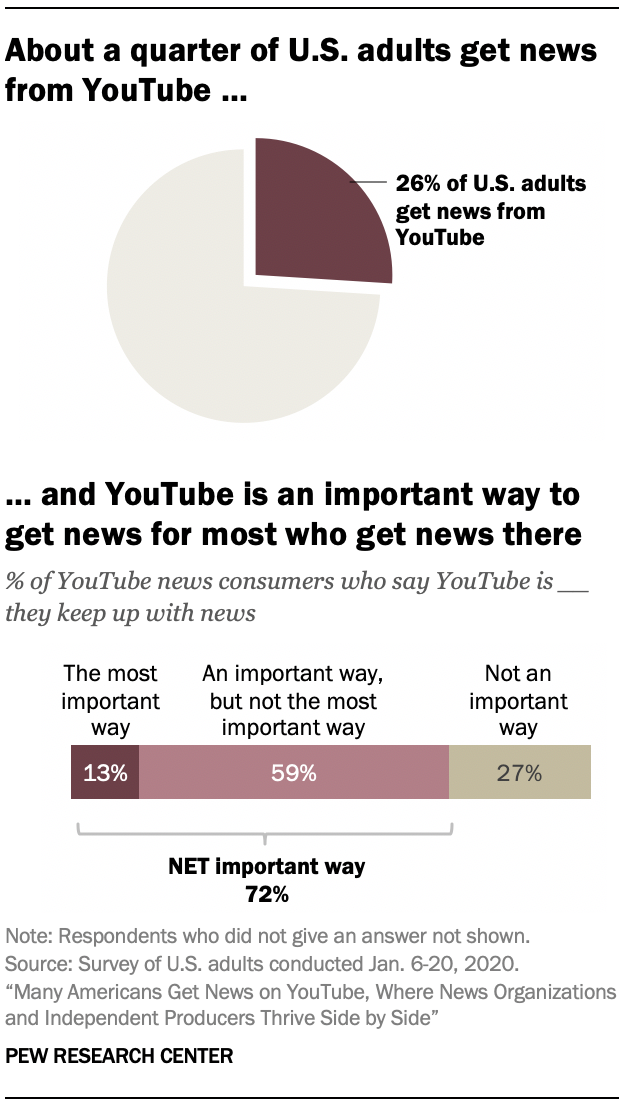 Most Americans use YouTube, the massive, Google-owned video-sharing website where users can find and watch content on almost anything, from dancing cats to popular music to instructions on how to build a house.
Most Americans use YouTube, the massive, Google-owned video-sharing website where users can find and watch content on almost anything, from dancing cats to popular music to instructions on how to build a house.
YouTube also has become an important source of news for many Americans. About a quarter of all U.S. adults (26%) say they get news on YouTube. And while relatively few of these people say it is their primary news source, most say it is an important way they stay informed.
This raises the question: What kind of news are Americans getting on YouTube, and who are they getting it from? A new Pew Research Center study explores these questions in two ways: through a survey, conducted Jan. 6-20, 2020, among 12,638 U.S. adults that asked YouTube news consumers about their experiences on the website; and through an analysis of the most popular YouTube news channels and the contents of the videos published by a subset of these channels in December 2019. For the content analysis, researchers used a combination of computational methods and trained human coders to identify the most popular YouTube news channels and comb through thousands of hours of videos looking for their topic, tone and other attributes (see Chapter 2 and the Methodology for details).
This study continues Pew Research Center’s analysis of Americans’ attitudes toward news on social media as well as the Center’s focused examination of the content on YouTube and how Americans use it. For a selection of further research, see:
YouTube
- 10 facts about Americans and YouTube
- A Week in the Life of Popular YouTube Channels
- Many Turn to YouTube for Children’s Content, News, How-To Lessons
Social media generally
- Americans Who Mainly Get Their News on Social Media Are Less Engaged, Less Knowledgeable
- Most Americans Think Social Media Sites Censor Political Viewpoints
- As COVID-19 Emerged in U.S., Facebook Posts About It Appeared in Wide Range of Public Pages, Groups
- Americans are Wary of the Role Social Media Sites Play in Delivering the News
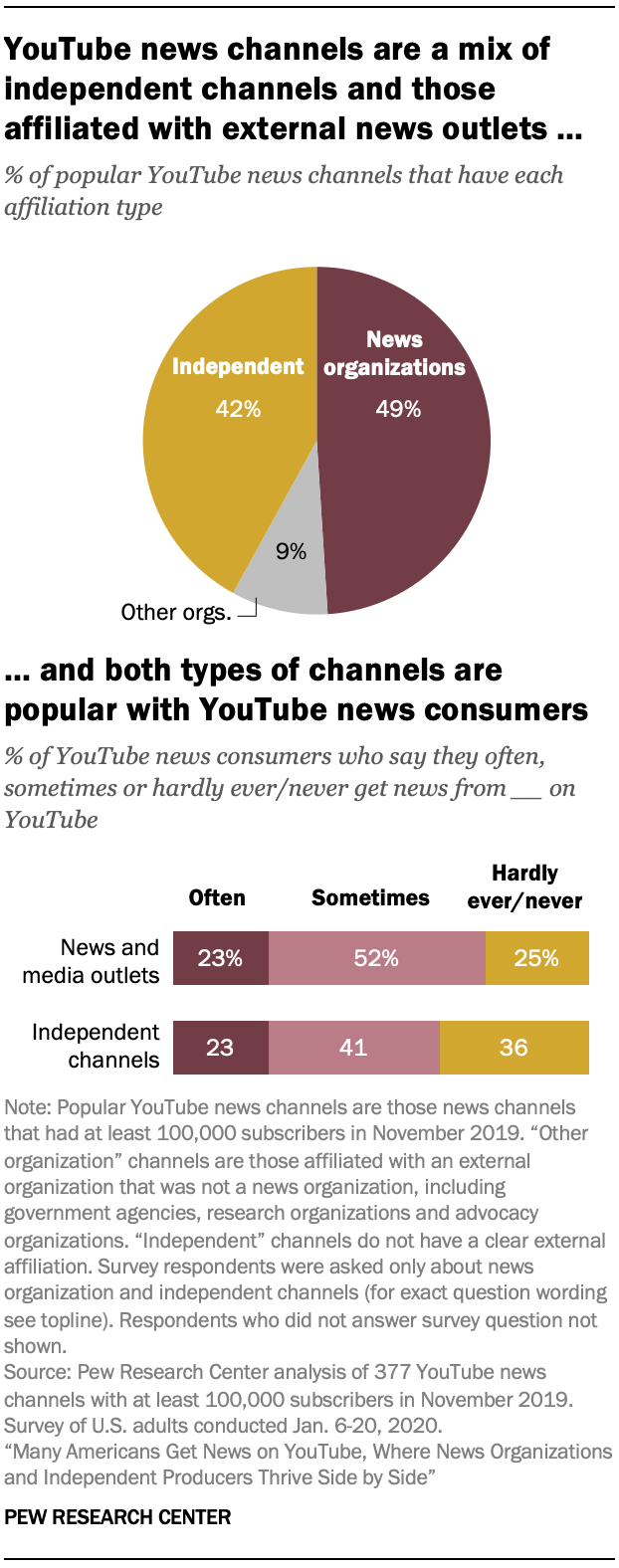 The study finds a news landscape on YouTube in which established news organizations and independent news creators thrive side by side – and consequently, one where established news organizations no longer have full control over the news Americans watch.
The study finds a news landscape on YouTube in which established news organizations and independent news creators thrive side by side – and consequently, one where established news organizations no longer have full control over the news Americans watch.
Indeed, the survey finds that most YouTube news consumers say they at least sometimes turn to news organizations as well as independent channels for news on the platform, and identical shares (23% each) often turn to each type of source. (Channels associated with news organizations are either the official channel of a news outlet, like CNN or Fox News, or one that features a particular program, show or journalist from these outlets. Independent channels do not have a clear affiliation with any external entity.)
The content analysis confirms that both of these channel types play prominent roles in the YouTube media ecosystem. The 377 most popular YouTube news channels are largely a mix of established news organizations (49%) and independent channels (42%), with the rest associated with other types of organizations (9%).1
There are several key differences between the content found on independent and established news organization channels. For instance, during the period analyzed (December 2019), news organizations posted a much higher volume of videos than independent sources (33 vs. 12 for the typical channel of each type), while independent channels’ videos were typically much longer (more than 12 minutes, compared with about five minutes for videos from channels affiliated with news organizations).
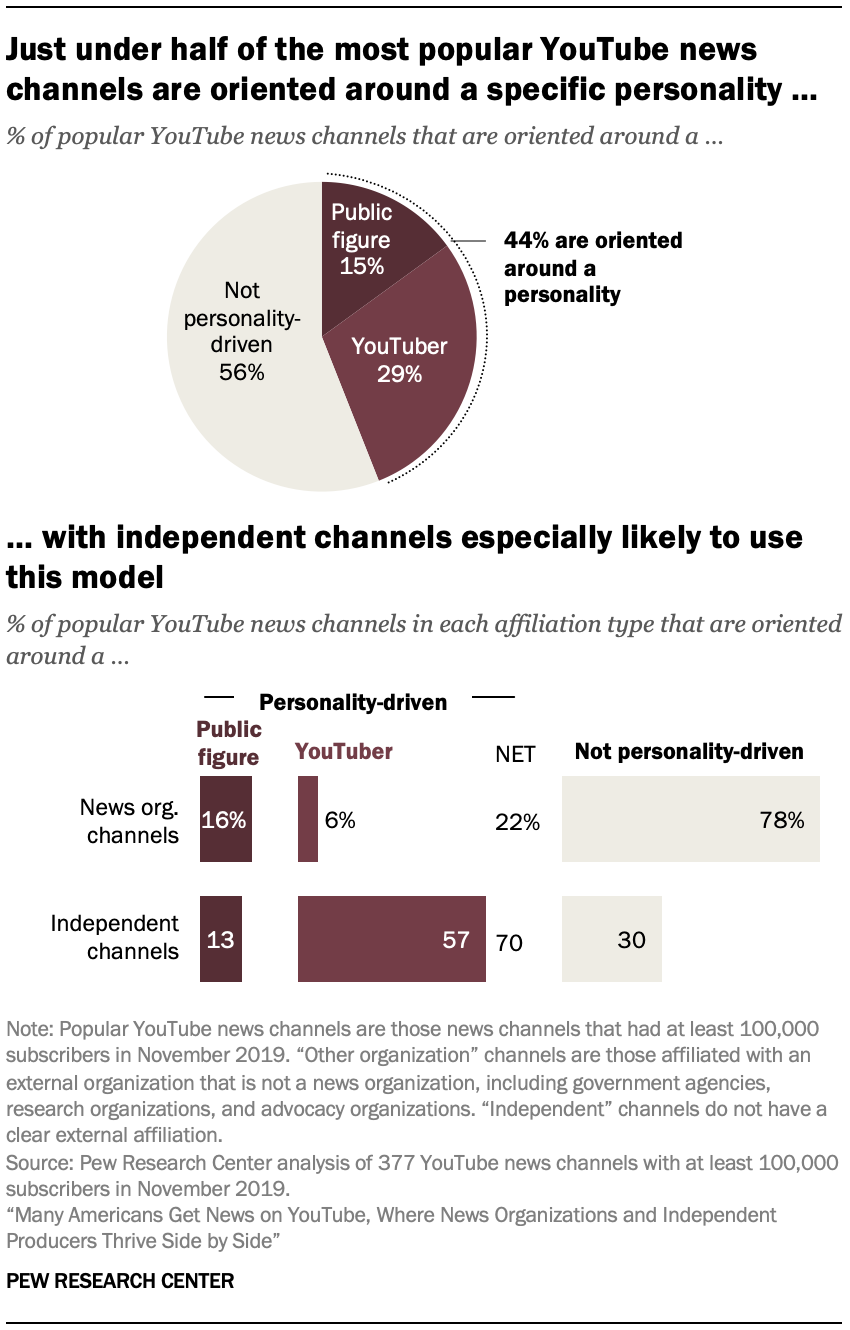
The content analysis also finds that most of these independent channels are centered around an individual personality – often somebody who built their following through their YouTube channel – rather than a structured organization.
While 22% of popular YouTube news channels affiliated with a news organization use this personality-driven structure, seven-in-ten of the most popular independent news channels are oriented around a personality. And the people at the center of most of these independent channels are often “YouTubers” (i.e., people who gained a following through their YouTube presence; 57% of all independent news channels) rather than people who were public figures before gaining attention on YouTube (13%).2
These different offerings and approaches to the news could have a variety of implications for the experiences of people who get news on YouTube. On the one hand, most YouTube news consumers seem to have a positive experience. Clear majorities in this group say in the survey that the news videos they watch on YouTube help them better understand current events (66%) and expect them to be largely accurate (73%). And a similar share (68%) say the videos keep their attention and that they typically watch closely, rather than playing them in the background.
Not only that, but when YouTube news consumers were asked to describe in their own words why YouTube is a unique place to get news, the most common responses relate to the content itself – including access to news sources outside the mainstream and the plethora of different opinions and views that are available on the platform. Indeed, YouTube news viewers are about as likely to say they are primarily looking for opinions and commentary on the website (51%) as they are to say they are mostly seeking information and facts (i.e., “straight” reporting; 48%).
Few YouTube news consumers see very big problems with getting news from the site
YouTube news viewers recognize that the platform is not without problems, but few find these problems to be very big. Critics and observers have raised a number of concerns about news on YouTube, ranging from misinformation and political bias to the control YouTube has over its content creators, both in terms of their content itself and their financial relationship with the website.
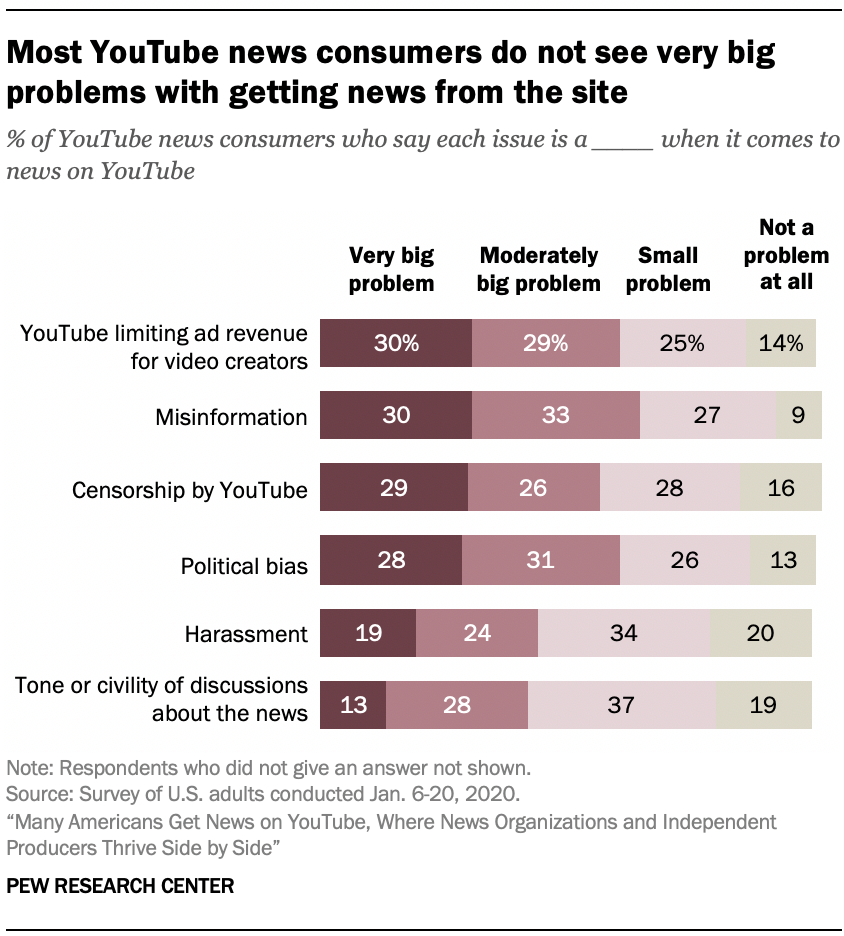 The survey asked YouTube news consumers about these issues, among others. While no more than three-in-ten say any of these are “very big” problems, majorities say a few of these are at least “moderately big” problems, including misinformation, political bias, YouTube limiting advertising revenue for video creators (also known as demonetization), and censorship by YouTube.
The survey asked YouTube news consumers about these issues, among others. While no more than three-in-ten say any of these are “very big” problems, majorities say a few of these are at least “moderately big” problems, including misinformation, political bias, YouTube limiting advertising revenue for video creators (also known as demonetization), and censorship by YouTube.
Fewer say that harassment or a lack of civility are very big problems when it comes to news on YouTube, but still at least four-in-ten say these are moderately big problems.
Republicans and Republican-leaning independents are more likely than Democrats and independents who lean Democratic to say censorship, demonetization and political bias are very big problems. Democrats, meanwhile, are more likely than Republicans to say misinformation and harassment are very big problems.
Independent news channels more likely to focus on conspiracy theories, cover subjects negatively
The content analysis suggests that some of these problems may be particularly big concerns when it comes to videos produced by independent YouTube news channels rather than those affiliated with news organizations.
 For instance, coverage of conspiracy theories was almost entirely concentrated among videos from independent channels and virtually absent from videos produced by channels affiliated with news organizations.
For instance, coverage of conspiracy theories was almost entirely concentrated among videos from independent channels and virtually absent from videos produced by channels affiliated with news organizations.
To determine the rate at which conspiracy theories were discussed, researchers analyzed videos to determine the extent to which they covered specific unproven claims or conspiracy theories that were prominent in news media in late 2019, particularly QAnon/deep state conspiracy theories, theories related to Jeffrey Epstein, and anti-vaccine theories.
Analysis of nearly 3,000 videos posted by the 100 most viewed YouTube news channels in December 2019 finds that 4% of all videos were primarily about the conspiracy theories studied. But when looking only at videos from independent channels, 14% were primarily about one of these conspiracy theories, and an even higher share (21%) at least mentioned one of these conspiracy theories. In contrast, just 2% of videos from news organizations mentioned at least one of the conspiracy theories studied and less than 1% were primarily about one.
Of these conspiracy theories, the ones collectively known as QAnon were the most commonly mentioned; 8% of videos from independent channels focused primarily on QAnon theories and 14% mentioned them, compared with news organization channels, which mentioned them in 2% of videos (and didn’t publish any videos that were primarily about them). Previous research has found that about half of U.S. adults (47%) say they have heard at least a little about the QAnon conspiracy theories.
In addition to being more likely to cover conspiracy theories, independent channels were more likely to produce videos with a negative stance toward their subject.
 While watching the videos from the top 100 most viewed YouTube news channels in December of last year, researchers assessed whether the tone of each video was primarily positive or negative toward the person or group it addressed. Overall, videos were more likely to have a negative evaluation of the person or group the video discussed than a positive one (22% vs. 4%), although most videos (69%) were neither overwhelmingly positive nor negative (see the methodology for details on how videos were coded).
While watching the videos from the top 100 most viewed YouTube news channels in December of last year, researchers assessed whether the tone of each video was primarily positive or negative toward the person or group it addressed. Overall, videos were more likely to have a negative evaluation of the person or group the video discussed than a positive one (22% vs. 4%), although most videos (69%) were neither overwhelmingly positive nor negative (see the methodology for details on how videos were coded).
But negativity was notably more common in videos from independent channels – 37% of the videos produced by independent channels were negative, compared with 17% of videos from news organizations.
Moreover, negative videos were especially popular, drawing more views on average than other videos. Across all different types of channels, videos that were predominantly negative in tone received an average of 184,000 views, compared with 172,000 views for videos with a mixed or neutral tone and 117,000 for positive videos.
Donald Trump on YouTube: Videos about the president made up the biggest chunk of news videos and were viewed by more people
The examination of videos also highlights the important role that President Donald Trump played in news videos in December 2019: Videos that discussed topics related to his presidency or focused on him more generally received far more views than other videos.
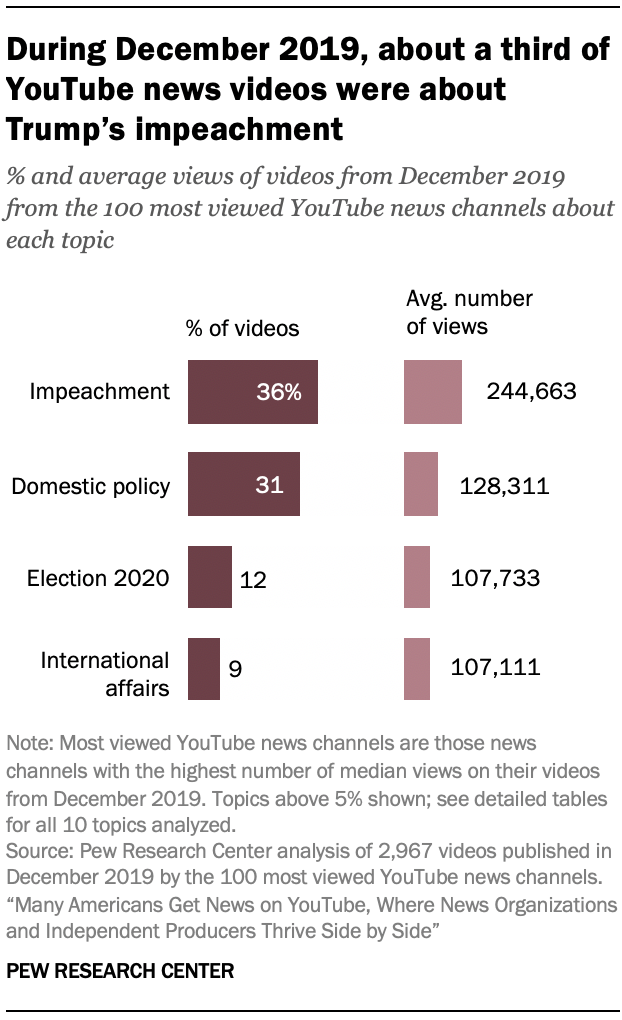 The 2,967 videos that were examined were all posted in December 2019, during which time the U.S. House of Representatives voted to impeach Trump on charges of abuse of power and obstruction of Congress. In this context, impeachment was the most common topic of videos posted by the 100 most viewed YouTube news channels during this time.
The 2,967 videos that were examined were all posted in December 2019, during which time the U.S. House of Representatives voted to impeach Trump on charges of abuse of power and obstruction of Congress. In this context, impeachment was the most common topic of videos posted by the 100 most viewed YouTube news channels during this time.
At the same time, however, the 2020 election, which at that point was largely centered around the race for the Democratic nomination, was featured much less frequently. Despite several months of Democratic debates – including one during December 2019 – just 12% of videos were about the election. This is a third of the proportion of videos that were about the impeachment.
Other common topics included a range of domestic policy areas (31% of videos), including abortion, gun control, immigration and international affairs (9%).
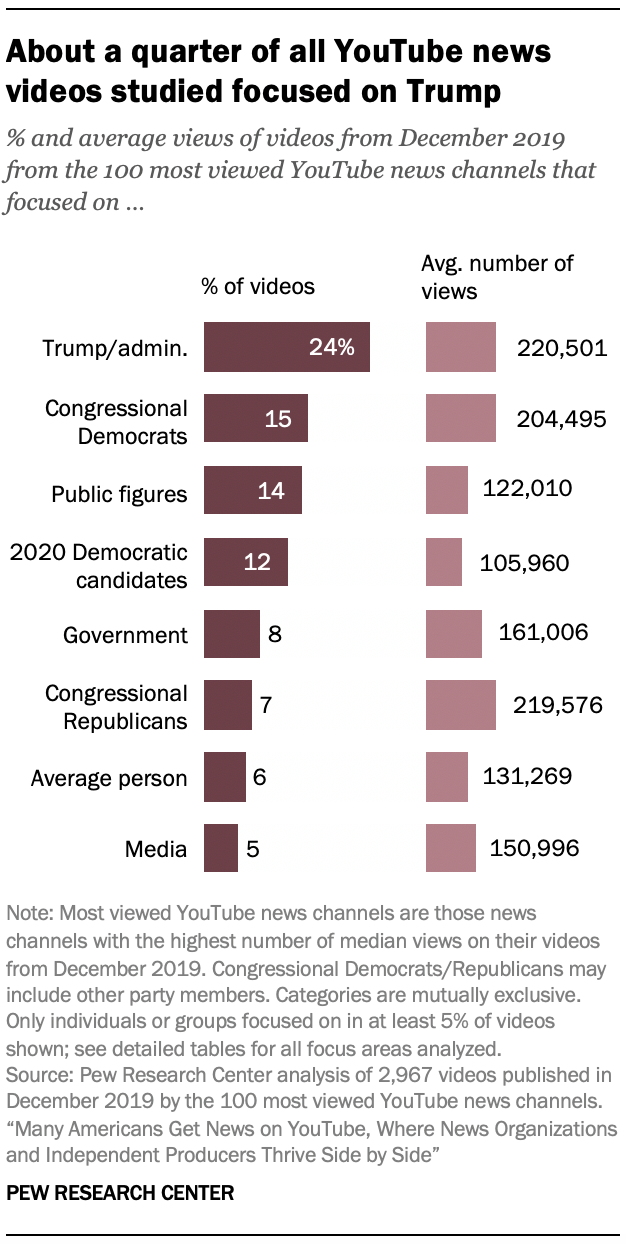 The president’s presence showed up in other ways as well. For instance, more videos focused on Trump than any other person or group across all videos in December 2019 – no matter the topic (while topic refers to the primary story being discussed, focus describes the person or group the video is about; e.g., a video could be about impeachment but be focused on the president or Congressional Democrats). About a quarter (24%) of all videos studied focused on Trump or his administration, with the impeachment inquiry being the most common topic of those discussions.
The president’s presence showed up in other ways as well. For instance, more videos focused on Trump than any other person or group across all videos in December 2019 – no matter the topic (while topic refers to the primary story being discussed, focus describes the person or group the video is about; e.g., a video could be about impeachment but be focused on the president or Congressional Democrats). About a quarter (24%) of all videos studied focused on Trump or his administration, with the impeachment inquiry being the most common topic of those discussions.
And this also shows up in how popular videos are: Simply put, videos that featured the president got more views than others. Videos that were primarily about Trump’s impeachment or Trump’s administration averaged 245,000 and 257,000 views, respectively, while those about other topics averaged 122,000 views. And no matter what the topic, when Trump himself was the main focus of a video, those videos received 221,000 views on average, compared with 157,000 among all other videos.
The president’s prominence in these videos also appears to shape what viewers take away from them. In an open-ended question, the survey asked what political or social issue YouTube news consumers learned the most about from watching YouTube news in the year before the survey (which was conducted in January 2020), and a third mentioned Trump or his administration – more than any other category.
Other key findings from the study include:
- Amid a debate about whether YouTube is an engine for political “radicalization,” the study finds that about half of YouTube news consumers describe the overall body of news videos about politics and social issues on the website as moderate. About a third (32%) see them as liberal and a smaller portion (14%) view them as conservative. When it comes to social media more broadly, about half of Americans (48%) say the news posts they see there are mostly liberal, according to previous research.
- An examination of the most popular YouTube news channels shows that the vast majority do not clearly state a political ideology on their channel page – regardless of whether the contents of their videos take an ideological slant. Only 12% of popular YouTube news channels explicitly include language about their ideology in the channel description, with slightly more identifying as right-leaning (8%) than left-leaning (4%). Independent news channels, however, are somewhat more likely than news organization channels to describe themselves in partisan terms and are more likely to say they lean right.
- Media and politicians were the most common sources cited in YouTube news videos. About half of all videos analyzed cited the news media as a source of information (51%), and a slightly smaller portion of videos (42%) cited a prominent Republican or Democrat, including Trump, the 2020 Democratic presidential candidates, or members of Congress.3 News organization channels were much more likely than independent channels to cite politicians (49% of videos from news organizations vs. 25% of videos from independent channels), while independent channels were more likely to cite the news media (68% vs. 45%).
- Independent channels are far more likely than news organizations to raise funds through their channels (71% vs. 14%). Overall, about four-in-ten of the most popular YouTube news channels (41%) accept donations through a variety of methods – most commonly Patreon, a site where fans can support creators financially.
The rest of this report looks at these and other findings in greater detail. Chapter 1 focuses on the findings from the survey of YouTube news consumers conducted in January 2020, while Chapter 2 examines the results from the analysis of the most popular YouTube news channels and the videos posted to the top 100 most viewed channels in December 2019.


